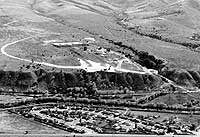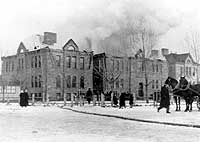
|
Page
122
|
 |
| Aerial view of the Pocatello West Bench and location of Pocatello water department. At end of the straight gravel road is the reservoir built by James Murray, which provided Pocatello's water as a private company until 1916. The reservoir north of the road was built in 1892. The large white structure south of the circular tank was built in 1935, but leaked and was not used long. A new State women's prison was built in 1994 on the site south of the water buildings. City Creek, the source of the first Union Pacific water supply is on the right side of the view. A right-of-way for a water pipeline was provided for in the Act of 1888, (June, 1991). |
St.
Joseph's Catholic Church
Catholicism was
the most successful European religion in the western United States during the
early fur trapping period. In efforts to convert Native Americans to the white
man's religion, Catholics were much more successful than Protestants, the trappings
and mysticism being more attractive than the straight-laced Calvinist doctrine.
Beginning with the missionary zeal of Father Pierre Jean De Smet in 1840, there
was a strong Catholic presence among the Pioneers, the railroad workers and
the early settlers in Idaho Territory.
An Idaho Vicariate was formed in Boise in the 1860s and this church served the religious needs of Idaho Catholics in the Pocatello area until 1889. At that time, a small church was erected in the 100 block of South Garfield. In 1891, the present properties where St. Joseph's Church and Convent are located were obtained, but the church on South Garfield continued to be used and a parochial school was conducted in the building beginning in 1892.
The small church could not accommodate the school and growing church attendance and in 1896 ground was broken on the present property for a permanent church which was completed and dedicated in 1897.
Growth was constant and in 1914, St. Anthony Church was built on the east side (the ethnic side) of town. In 1919, ground was broken for a school building and convent next to St. Joseph's church.
The
Need for Water in a Semi-Desert City
Early Pocatello
used the Portneuf River for all its water needs. Hemmed in by the reservation,
and severely so until 1888, the railroad junction had other problems than a
pure source of water. Since the site was a barren sagebrush flat and covered
with fine loess soil, the perennial late summer winds made it a dusty and scruffy
place.
Pocatello
Portrait and the Water System
The book "Pocatello
Portrait" by H. Leigh Gittins, chronicles the early history of the city
and especially the water system. A group supported by banker James A. Murray
of Butte, Montana developed the first water supply in Pocatello in 1892, from
Gibson Jack and Mink Creeks. Parts of the flume can be still seen on the north
side of Mink Creek. A reservoir was built on the West Bench, and trees were
planted. After fifteen years, this had become a "beautiful park-like area."
In 1893, the city attempted to buy the system from Murray, but the matter was
defeated by the city council. As was predicted at the time, this was an expensive
mistake for the growing city. Murray was never anxious to spend his money to
upgrade the system and conflict continued for twenty years.
 |
| Fire destroys Pocatello High School, December, 16, 1914, two years before the city obtained control of its water system. After this fire and a severe drought in 1915, fire underwriters refused to insure the city because of low water pressure. The new Pocatello High School was built on the same spot, and opened two years later, in 1916. A major addition, including the gymnasium, was built in 1939. Bannock County Historical Society Collection. |
In 1898, an outbreak of typhoid fever caused alarm, as did the customary finding of dead gophers, toads, and rotting debris in the screens in the reservoir. In 1898 the City Council established water rates favorable to Mr. Murray, and for a time he and his water superintendent George Winter took better care of his system. In 1899, the city council passed an ordinance to contract for sprinkling of parts of the downtown streets. Since no one had water meters, excessive use could not be controlled, and summertime water shortages were standard procedure. A fire during a time of low water pressure would have been disastrous. The Union Pacific Railroad provided water from Batiste Springs west of town during emergencies.
Droughts and Urban Conflict, 1900s Style